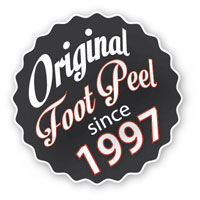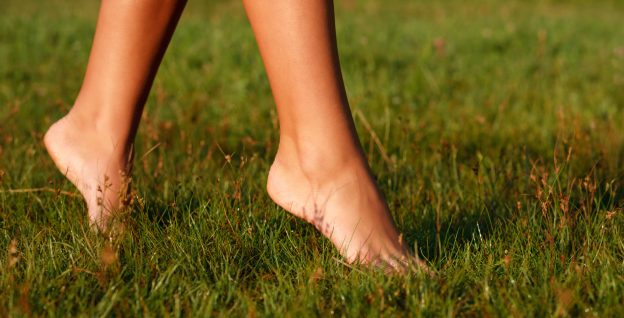Aside from maybe spending time in the sun, there are precious few activities that walk the line between healthy and risky like going barefoot.
Freeing your feet from the perspiration-soaked prison of socks and shoes is something most of us can appreciate. But whether you fully endorse or strongly oppose barefoot life depends on your personal experience.
If sole-baring walkabouts boost your mental and physical well-being, you’re likely a card-carrying member of the carefree barefoot camp. Unless, of course, your foray into this more vulnerable lifestyle went horribly awry and forever soured you on the idea of sauntering about shoeless.
Stepping on a nail or picking up a nasty fungal infection are just a couple of the dangers of walking basefoot and can quickly swing you to the opposite end of the spectrum. Now you don’t go anywhere without a protective layer to shield your feet from peril. We can’t say we blame you.
As research into the health benefits of being barefoot continues to enlighten us, the various hazards—and resulting horror stories—are reason enough to play it safe. Let’s break down the good and bad of traipsing across terra forma in bare feet.
Health Benefits of Walking Barefoot
The barefoot faithful have fully embraced a footloose way of life they say is holistically healthier than that of their shoe-clad counterparts. A number of scientific studies appear to back up their claims that our bodies benefit when our feet come in direct contact with the ground. Let’s take a look at the pros and cons of walking barefoot.
Antioxidant effect
Wait. What? Yes, coffee, blueberries and salmon are packed with antioxidants, but electrons on Earth’s surface may have a similar effect when absorbed through your skin. Antioxidants fortify your cells against “free radicals,” those unsettled molecules that assault your immune system with stress, inflammation and disease.
When your bare feet come into contact with the ground, a practice called “grounding” or “earthing,” the transfer of electrons helps to stabilize these molecules. It sounds far-fetched, but research shows that being literally more grounded can help lower cortisol levels, promote healing and improve sleep quality. Earthing also has been shown to reduce blood viscosity, which can lead to cardiovascular disease.
Natural calluses
There’s been plenty of debate about barefoot running and whether those expensive sneakers are actually helping or harming your natural foot mechanics. In 2019, Minimalist footwear company Vivobarefoot released a documentary short called “Shoespiracy” that argued all that cushioning and support is actually contributing to—not helping us avoid—chronic foot pain.
That same year, evidence emerged that running barefoot creates natural calluses that protect the bottom of your feet with no loss of sensation. The same study showed that runners wearing cushioned shoes were hitting the ground three times harder than those with calluses who were running barefoot. That’s tough on the joints and could explain the prevalence of knee arthritis.
Improved balance
In addition to creating a keratin sheath that better protects your soles, walking barefoot more often might prevent balance problems as we age. That instability can lead to later-in-life falls resulting in serious injuries.
It’s a fact: Shoes alter the way we walk—and not necessarily for the better. Decades of footwear dulls our tactile sensitivity and makes us less aware of where exactly our feet are positioned when moving.
Going barefoot gives you more control as well as improved mechanics that strengthen ankle joints, leg muscles, hips and your lower back. When you’re barefoot, you’re embracing your gait, or natural walking pattern. Many babies take their first steps when they’re barefoot—and for good reason.
Dangers of Walking Barefoot
Podiatrists are sometimes asked, “Is going barefoot bad for you?” The best answer: It can be. While the skin on the bottom of your feet is relatively thick, it’s far from impenetrable. Cuts and puncture wounds, however, aren’t all you need to worry about when wandering barefoot. Feet are susceptible to bacterial and fungal infections as well as certain types of parasites like hookworms. Many of these hazards are outdoors, but going barefoot indoors has its own risks.
Foot injuries
Metal. Rocks. Glass. Thorns. Insects with stingers. The threats are many when you’re tooling around in your bare tootsies. And one wrong step could be a painful reminder that your feet are indeed flesh and bone. Cuts, puncture wounds, sprains, bruises and those oh-so-agonizing stubbed toes are more likely when you’re unshod.
While they may hurt like heck at first, many of these foot injuries are easily treated and should heal relatively quickly. However, if a rusty piece of metal breaks the skin, you could be at risk for tetanus if you haven’t been vaccinated. The toxins in this nasty bacteria can cause involuntary muscle contractions and lock up your neck and jaw muscles, making it hard to swallow.
Awareness is key when you go barefoot outside. Stick to surfaces where you can see what’s on the ground. You never know what might be hiding in that tall grass or deep sand.
Bacterial, fungal or viral infections
You might not immediately think of feet as an entry point for infections, but they certainly can be. And going barefoot makes it easier for bacteria, fungus and viruses to infiltrate your body. Here’s a quick rundown of the organic infidels looking to attack your bare feet.
- Pseudomonas – Commonly found in soil, water and plants, this bacteria can be a problem if it makes contact with broken skin on your feet or via a puncture wound. If allowed to spread, these germs can cause a severe infection.
- MRSA – This so-called “superbug” is a staph infection that’s resistant to routinely prescribed antibiotics. Once primarily seen in health care settings, this highly resilient bacteria has been linked to common foot conditions. Avoid going barefoot in damp, high-traffic areas to steer clear of this potentially deadly bacteria.
- Athlete’s foot – On the fungal front, athlete’s foot is the old standby. Known for lurking in locker rooms and communal showers and around swimming pools, this fungus usually takes hold between your toes. Incessant itching and burning is a dead giveaway. Thankfully, this nuisance can be treated with topical ointments or over-the-counter meds. But beware—if left untreated, athlete’s foot can sometimes spawn toenail fungus.
- Plantar warts – If you’d rather not run the risk of having stubborn warts on your soles, you might want to throw on flip-flops or sandals when traversing warm, moist indoor surfaces. Certain strains of the human papillomavirus, or HPV, cause plantar warts, which can hurt and even grow inward. Yick!
Who knew there were so many pros and cons of walking barefoot? Do you go barefoot in summer? If so, those resulting calluses might be begging for one of our exfoliating foot peels. Exchange rough and ragged for soft and smooth. Now your feet are bare and beautiful!
If you spent too much time barefoot in the sun, be sure to read our tips on taking care of your sunburned feet!


